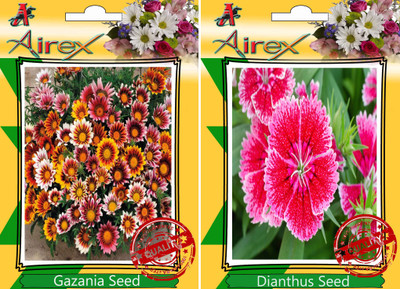Airex Gazania, Dianthus Seed(20 per packet)
Quick Overview
Product Price Comparison
Gazania Flower Seeds:Description:Overview: Leaves typically linear to linear-lanceolate (narrow and tapering to a point), up to 10 mm wide. The leaves are pinnately lobed (feather-like) and held in rosettes arising from a stout, woody crown (that part of the stem at the ground surface). The leaves are hairless on the upper surface, but the undersides are thickly covered with soft, white hairs, except around the midrib.Flowers: The solitary flower head (capitulum) is up to 7 cm wide and held above the leaves on a stem 10 cm or more long. The capitulum consists of two types of florets: the ŌĆśray floretsŌĆÖ at the margins and the ŌĆśdisc floretsŌĆÖ in the centre. The ray florets are generally golden yellow, often with a dark base, but are occasionally white with a yellow band near the base. The disc florets are yellow to reddish-orange.Gazania linearis is divided into two varieties: G. linearis var. linearis and G. linearis var. ovalis. Gazania linearis var. ovalis has broader leaves that are lanceolate (spear shaped) to elliptic (broadest at the middle with two equally rounded ends) and up to 25 mm wide. Both varieties are from the same region of South Africa.Dianthus Flower Seeds:Description:Dianthus are among our most favorite plants. Often called Garden Pinks, Their beguiling flower petals may be delicately fringed or ruffled, mostly in light shades of white, pink, and rose. Flecks, edges, or rings of darker colors add to their beauty. And the spicy-sweet fragrance is among the best of all flowers. The narrow leaves form neat mounds of greenish blue and the plants are perfectly suited in a rockery or as an edging. So highly regarded were they by the ancient Greeks that they gave them their name Dianthus, which means ŌĆśFlower of ZeusŌĆÖ, or ŌĆśDivine FlowerŌĆÖ.They grow best in full sun and a fast draining, slightly alkaline soil. They like even moisture; not too wet or dry. Little attention is needed other than deadheading, light shaping, and a bit of well balanced fertilizer in spring. Plants in hot, humid areas are best divided every few years to prevent rotting.Dianthus hybridize readily and have been bred for many centuries. They reached their zenith of popularity in Britain in the mid-1800ŌĆÖs, when it was common for nurseries to list hundreds of varieties. Most of our garden varieties have descended from just 3 of the nearly 300 species: Dianthus caryophyllus (the carnations), Dianthus barbatus (the Sweet Williams), and Dianthus plumarius (the garden pinks), with much interbreeding between them. We have always favored the garden pinks for their true perennial nature, cold hardiness, and winsome charm. No cottage garden pathway would be complete unless there were patches of garden pinks drifting lazily across the stones and the air was laden with their lovely fragrance.


